#1760s undergarment
Text
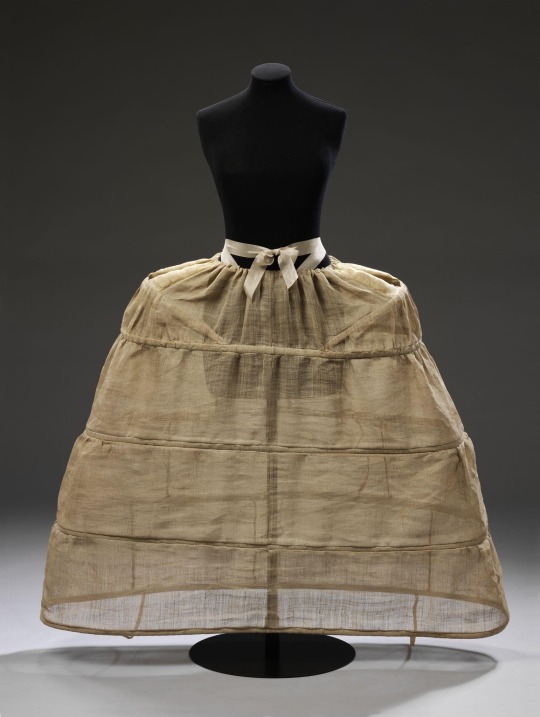
Beige Linen Hoop Skirt, 1760-1780, Irish.
Victoria and Albert Museum.
#beige#linen#Irish#1760s ireland#1770s Ireland#1760s#1760#1770s#womenswear#extant garments#1760s hoop skirt#hoop skirt#V&A#1770s hoop skirt#1760s undergarment#1770s undergarment#1760s extant garment#1770s extant garment
31 notes
·
View notes
Photo

Chemise, Stays, & Panniers
c.1760-1780
Throughout the eighteenth century, the silhouette of a woman's dress was formed with a corset or a pannier. In order to push up the bust for a feminine outline, the [stays were] framed with pieces of whalebone. First appearing in the early eighteenth century, the pannier became a mandatory item for court dress up until the time of the French Revolution. As the skirt widened in the mid-eighteenth century, the pannier was modified and split into left and right halves. Such huge panniers frequently became the subject of caricatures.
Kyoto Costume Institute (AC337 77-12-51, AC7682 93-1-4, AC6289 89-4-6)
#fashion history#historical fashion#1760s#1770s#1780s#18th century#rococo era#georgian era#chemise#stays#panniers#undergarments#intimate apparel#cotton#satin#linen#kyoto costume institute#kci
402 notes
·
View notes
Text
Madame de Pompadour Pt. 1 - Undergarments
The first step in any historical costuming project is always the undergarments. Although it can be tempting for many to immediately start on the dress, having the proper undergarments already made will ensure the perfect fit and the proper silhouette. Thus, for my Madame P dress, I needed to have the proper undergarments.
My journey started by researching the typical undergarments of the period and place. Since I was attempting to recreate a dress in a 1754 French portrait, I focused on that time period (mid 1750s) in France. I already had a basic idea of how 18th century clothes fit together, but I needed a specific idea of how it would have looked in the 1750s.

The basic elements of the 1750s undergarments were a shift, stay, and panniers. The French liked oblong panniers with a stay that smoothed out rough edges. However, I began to realize that historical accuracy was not as important to me as getting this dress done before my prom. 🙃 So, I relied upon the American Duchess x Simplicity collection: #8579 & #8678.

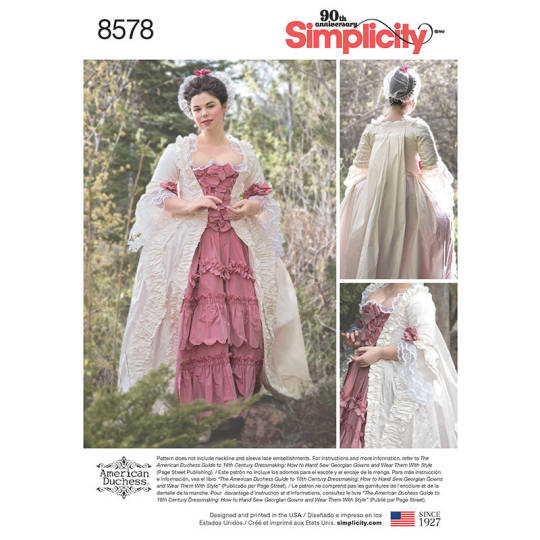

So, I set to work making the shift. It was pretty straightforward, nothing super complex here.


Then came along the stay. I knew that this would be one of the most tedious parts of this project, as I had to sew ALL of the boning channels and make ALL of the grommets...


Marking for the grommets... on the MUSLIN!


Front and back of my muslin toile. Unlike what the back of the stay tell you, it actually did fit me well, but my lady's maid didn't really know what she was doing (totally not because I didn't explain it well, pshhh...) Hallelujah for being close to the pattern size measurements! Also, excuse me for using my um, assets, to secure the straps in place, I didn't want to sew on hooks on my toile.
Once that was out of the way, I needed to make the actual stay. Because I am not wealthy, I used thick cotton batting instead of coutil for my stay. It worked surprisingly well, and provided that much-needed stiffness to my stay.
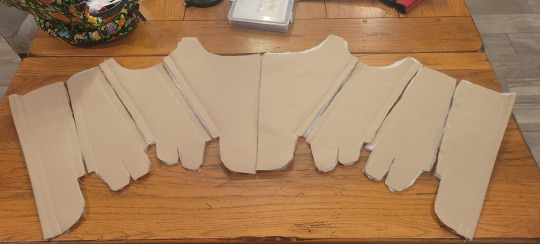

Before & after I sewed the boning channels. It took me two whole days to make them!


Finally, I had finished the stay. Sort of. As of when these pictures were taken, I hadn't finished the bottom of the stay. Also, these photos are subject to a hasty lacing-up that allowed for a large bulge between the back panels, but I swear, it does fit well!

Next, onto the panniers. There really wasn't much to say here, as they were pretty straightforward. They aren't quite accurate to the time period, but it works well enough for my silhouette. It was also really fun to melt the sharp edges off the plastic boning over an open flame!


Woo! I'm done! I've been procrastinating on posting this for a long time, and at the time of writing, I'm nearly finished with the gown trimmings. Hopefully I'll have something more soon! Ta-ta for now!
#projects#madame p boucher dress#undergarments#historical costuming#historical fashion#1760s#18th century
1 note
·
View note
Text
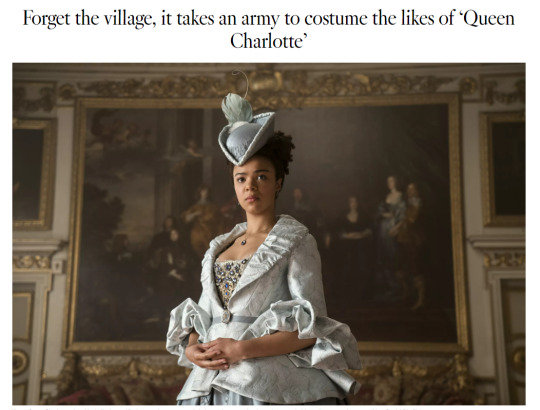
Young Queen Charlotte, played by India Amarteifio, keeps to innocent pastels in her early scenes, but her colors grow bolder as her power does too. (Liam Daniel/Netflix)
BY VALLI HERMAN
In the first minutes of the “Bridgerton” prequel “Queen Charlotte,” the namesake character complains heartily how her elaborate gown and its restrictive corset made of brittle and sharp whalebone means that if she moves too much, “I might be sliced and stabbed to death by my undergarments.”
Oh, dearest gentle reader, young Queen Charlotte hasn’t suffered in vain. Her every ensemble, and those of the show’s sizable cast, are crafted with such sumptuous detail, that surely all who view them would gladly have them suffer even more.
Even though period costumes are notoriously cumbersome, Emmy-winning costume designer Lyn Elizabeth Paolo and co-costume designer Laura Frecon dispel notions that the actors suffered much (thanks to light, modern fabrics and stretchy panels in their corsets). Still, the yearlong shoot in grand estates across the United Kingdom overlapped the pandemic lockdown and required worldwide sourcing. It seems that their brand of elegant finery was a tonic for distress, and a cause for celebration. The work, helped by a 220-person costume crew, has earned them a 2023 Emmy nomination for period costumes.
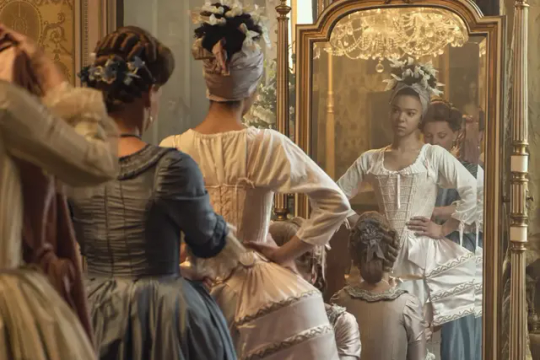
Replica undergarments were crafted from light, modern fabrics and stretchy panels to be slightly more comfortable than the actual period clothing. (Liam Daniel/Netflix)
“This [shoot] was challenging, but also joyful. Every time a piece of a costume would come back, it was, ‘Oh, my God! It looks better than we thought it would.’ There was a lot of joy there,” says Paolo, the longtime designer for other Shonda Rhimes productions, such as “Inventing Anna” and “Scandal.”
The six-episode costume drama on Netflix explores the early days of the difficult marriage of Queen Charlotte (India Amarteifio) and King George III (Corey Mylchreest). The fictionalized story of the actual royals takes place in two time periods — the Georgian era of the 1760s and the later Regency era in which “Bridgerton” is set — and includes key characters from the original show. There are several grand balls, a royal wedding and a coronation to wardrobe. No biggie.
Or so Paolo was led to believe.
“I remember Sara Fischer, who is head of production at Shondaland, called me and said, ‘Shonda has this idea for a small, intimate show. She really wants you to do it.’ And, what are you going to say?” recalls Paolo, who was a consultant on Season 2 of “Bridgerton.”
She invented a time-twisting concept inspired by Monet and Matisse paintings and modern fashion designers who themselves referenced historical costume such as John Galliano, Alexander McQueen, Moschino, Zuhair Murad and Christian Dior in his New Look era. Yet Paolo kept the silhouette appropriately Georgian.
“The pitch was, we kind of want it to look like a Met Ball … but to be slightly more on point with the period. We still wanted to have our own stylistic elements that would make sure that the modern eye understood the costumes,” Paolo says.
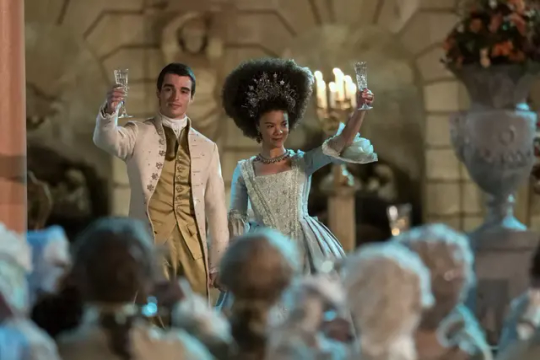
Corey Mylchreest as King George and India Amarteifio as Queen Charlotte all but sparkle in their lustrous clothing. (Nick Wall/Netflix)
“For the men, we had images of rock ‘n’ roll icons from the ‘70s and ‘80s. So a lot of images of Prince, the New Romantics and Adam Ant. All those people back then who had that pirate chic going on.”
That vision required a mostly custom-made wardrobe that sourced from London, Los Angeles, New York, Budapest and Spain. Jewelers Joseff of Hollywood, Manhattan’s Larkspur & Hawk and Italy’s Pikkio custom made the period jewelry and other adornments. British manufacturer James Hare supplied traditional fabrics as did a mill hours from London that wove custom fabrics. Smaller artisan shops focused on hand embroidery or a particular character.
“It was sort of a small army,” says Paolo, who relied on the organizational skills of Frecon. A giant calendar and flow chart helped them track the flow of work, particularly of the embroidered pieces, which were outsourced to UK specialists Twan Lentjes Creations, Beth Parry and Hattie McGill, whose Instagram accounts illustrate their handiwork.
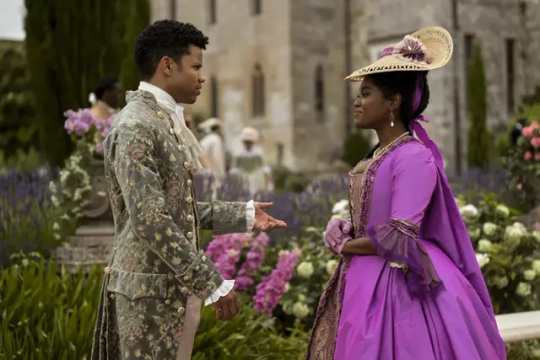
Other members of the court stand out in patterned fabrics (on Tunji Kasim as Adolphus) and brightly colored gowns with hats (Arsema Thomas as Agatha Danbury).
“It’s so complicated,” Paolo says, describing a process of sample making, initial embroidery, further tailoring and additional hand embellishing before a pattern piece is ever fitted into a garment. Even fabric-covered buttons were embroidered.
The women’s gowns are especially intensive. The earlier dresses, from 1760 onward, required 13 to 20 yards of fabric and at least four weeks of construction; five if they’re heavily embellished. Each ensemble requires petticoats that can add five to 10 more yards each, plus a corset, a pannier (a cage-like underpinning), a padded bum roll, shoes, stockings and garters. The jewelry sets were matched to each costume and included rings, earrings, necklaces, bracelets and tiara-like hair jewelry that was fitted into fantastical wigs by hair and makeup designer Nic Collins.
With two sets of characters to dress in two different eras, the costume designers were careful to build visual continuity, typically with color. Young Queen Charlotte, for example, keeps to innocent pastels in her early scenes, but her colors grow bolder as her power does too. The designers cannot precisely count the number of costume changes, or quantify the number of pieces they used, only to say “in the thousands.” Paolo says Jeff Jur, director of photography, was on board to capture the spectacle and regularly texted her and Frecon to say, “‘I’m doing a full head-to-toe shot of this one.”
Still, it’s tricky to absorb all of the detail, even though it’s there on the hand-embroidered initials on a man’s handkerchief, or the restored antique jet beading and lace on Queen Charlotte’s mourning gown, or the Easter eggs, as Paolo calls the references she wove into many costumes, particularly those in the final episode, which features an astronomy-themed ball, hosted by the king and queen.
King George loves astronomy, so stars and moons are embroidered and beaded into their clothes. The ball was shot outdoors at night, which usually obscures costume details. Jur expertly lit the scene to illuminate the clothes that were so laden with sparkly bits that they twinkle.
Though the final episode was picked to submit for Emmy consideration, the choice was “brutal,” Paolo said. “It’s a huge group of amazingly talented people who all deserve recognition. If we are lucky enough to win, I would want 220 miniature ones to hand out to everyone.”
#queen charlotte: a bridgerton story#india amarteifio#corey mylchreest#queen charlotte#king george iii#charlotte x george#charlottegeorge#tunji kasim#arsema thomas#prince adolphus#lady danbury#netflix#!
47 notes
·
View notes
Text

'La M. de la Corsets': c. 1832 lithograph showing a dressmaker or tailoress and client. The undergarments depicted include sleeve-plumpers.
1830s Thursday: Big sleeves, and even bigger dreams for women’s rights.
The growing vulnerability of working women in industrial society provoked a forceful response. In 1825 hundreds of them went out on strike against New York City clothing houses. In 1831 these same women organized themselves into a mass-membership United Tailoresses’ Society. At a time when journeymen were still devoting their political efforts to a defense of artisanal prerogatives in the master’s shop, these “tailoresses” (the appellation itself testified to an advanced degree of industrial consciousness, excluding as it did the more traditional dressmaking of the “sempstress”) already understood that in a capitalist economy no aspect of the work relationship remained non-negotiable. [...]
No one can help us but ourselves, Sarah Monroe, a leader of the United Tailoresses’ Society, declared. Tailoresses should consequently organize a trade union with a constitution, a plan of action, and a strike fund. Only then could we “come before the public in defense of our rights.” The Wollstonecraftian rhetoric was conscious. Lavinia Wright, the society’s secretary, argued that the tailoresses’ low wages and hard-pressed circumstances were a direct result of the way power was organized throughout society to ensure women’s subordination in all social relations.
— Michael Zakim, Ready-Made Democracy: A History of Men's Dress in the American Republic, 1760-1860
I was disappointed in my search for pictures of Sarah Munroe, Lavinia Wright, or really anything to do with the United Tailoresses’ Society. One online article outright stated, “We know very little about this speaker, Sarah Monroe, other than that she was a garment worker and president of the newly formed United Tailoress Society -- the first women-only union in the United States.”
I am in awe of this working-class woman, Sarah Monroe, who is quoted by Michael Zakim as saying in 1831:
It needs no small share of courage for us, who have been used to impositions and oppression from our youth up to the present day, to come before the public in defense of our rights; but, my friends, if it is unfashionable for the men to bear oppression in silence, why should it not also become unfashionable with the women?
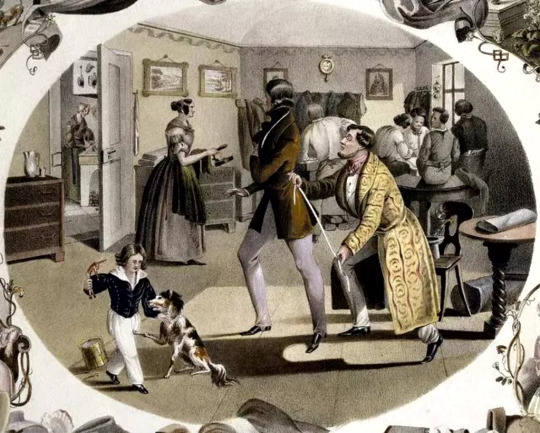
'The Tailor's Shop': 1838 lithograph by Carl Kunz and Johann Geiger
#1830s#fashion history#labor history#labour history#us history#sarah monroe#Eighteen-Thirties Thursday#united tailoresses' society#michael zakim#women's history#also i have been sleeping on michael zakim's book it's really good#there were many strikes by female garment workers in the time period#amazingly forward-thinking they were trying to get sick pay and retirement benefits#they also campaigned against prison labour#tailors#dress history#inequality#industrial relations#19th century
380 notes
·
View notes
Text
Been super into time travel fics lately. My fav part (aside from Buffy meeting William) is the essential fashion montage. You know, where Buffy goes shopping or has somebody buy her a bunch of new clothes suitable for a pretty lady of the era?
Since I've already done a jewelry spam, here's some corset references for the lovely writers out there 🙂

Like all fashion trends, corsetry changed through the years. Some of what we refer to as corsets were actually known as stays. Those are stiffer and have more boning than corsets.
Stays kind of developed into corsets. So Darla and the women of Liam's time would have worn stays, but Drusilla and the women of William Pratt's day would have worn corsets.

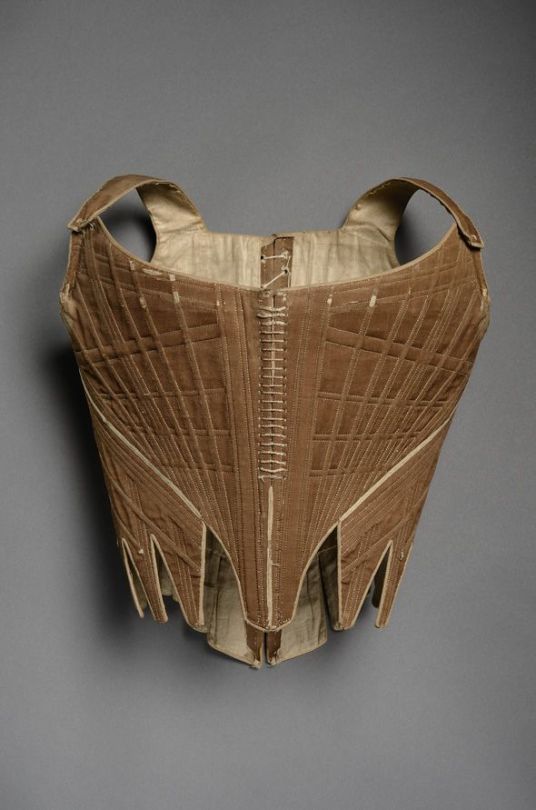
Here are two examples of stays from the late 1700s. The first is from 1740-1760, the second 1770-1780.
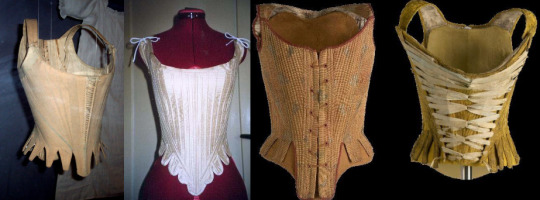
Some stays from the 1600s. I'm not entirely sure which decade in particular each are from, but these are along the lines of what Darla would have been wearing.


There's not a whole lot of pieces that have survived this long, but here's two from around the time Darla would have been alive.
You can probably see what I meant when I said stays had more boning than corsets. It's very tight with few gaps between, creating a firmer conical shape than most corsets.
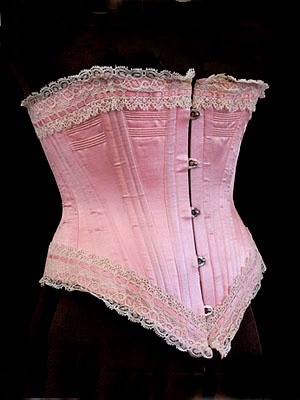

The first is a real corset from the late 1800s, the second a reproduction. As I mentioned earlier, fashion varied significantly from decade to decade throughout the 1800s. If you're having a character picking out an entirely new wardrobe, it's best to find references by searching "18xx's fashion" as opposed to just "Victorian fashion" or "1800's fashion".
Otherwise, you might end up describing a totally anachronistic silhouette. Like putting clothes from a 70's bargain bin on a character from 2004 and calling it "the newest look". (Unless ofc this is entirely unimportant to you because you're not a massive dork).
Anyway, another Very Important Thing about corsets. They were not uncomfortable. They did not restrict breathing or movement. Tightlacing was not mandatory. Farm workers, maids, and aristocrats alike wore corsets or stays every day for centuries and got through their lives just fine.
A properly fit corset provides support for both the breast and back. It's obviously more constricting than being naked, but so are bras and clothing in general. Some women who've tried reproduction corsets that were tailored to their bodies even say they find it more comfortable than a bra.
Contrary to the modern idea that corsets are a symbol of woman's oppression, the idea that corsets were painful or harmful actually comes largely from sexist men who looked down on women's fashion trends.
Basically, it'd be really cool to see a scene where Buffy puts on a corset that was made for her and is surprised by it not literally being the worst thing ever.
OH! And while we're on the topic of Victorian undergarments, one thing I never see in fics is an accurate depiction of their underwear. Yes, they were silly frilly shorts. They also had a slit down the middle to allow women to pee without taking their skirts off. Their coochies were easily accessible if you got through all the skirts and it's a crime that more people don't know about this.
13 notes
·
View notes
Text
Queen Charlotte

Queen Charlotte: A Bridgerton Story is a historical drama series created by Shonda Rhimes. The series is a prequel spin-off of the Netflix series Bridgerton. The story is loosely based on the rise of Charlotte of Mecklenburg-Strelitz to prominence and power in the late 18th century.
youtube
Here is the trailer for Queen Charlotte showing a quick in sight into the plot of the series as well as some of the many extravagant costumes worn by the characters.
The Inspiration
Lyn Elizabeth Paolo and Laura Frecon, the costume designers of Queen Charlotte: A Bridgerton Story, sourced inspiration from all over the world in a quest to find the best products available to bring the series to life showcasing the exquisite fashions of the time. They visited museums, silk mills and jewellery houses in Spain, Italy, England and the US. Along with this they custom-made hundreds of 1760s- accurate undergarments in order to fully resemble the fashions of the era.
Furthermore, although the series is fictional nearly all aspects of the costume design was taken from the history of the time; Georgian silhouettes and exact replica crowns created by Italian jeweller Pikkio.
Due to the incredible fabrication of all the costumes Lyn Elizabeth Paolo and Laura Frecon along with assistant costume designer Jovana Gospavic and costume supervisor Alex Locke, were nominated for an Emmy in the Outstanding Period Costumes for a Series category.

To create more interesting costumes and attract a larger audience Paolo and Frecon added a more modern aesthetic to the designs in which Frecon describes as "high fashion meets period style, with a twist."
In particular, 50s Christian Dior and Roger Vivier inspired many aspects of their designs adding these unique element to the costumes, not traditional seen in the Georgian Era. Paola states “Dior was a huge inspiration for us, especially because I think a lot of the Dior New Look actually came from this period, that shape and that silhouette. We were echoing the 1760s and the late 1940s, 1950s, and that Dior New Look is reflected in many of the costumes on the show.”
In addition, to fit with the show's modern take on aristocratic aesthetics we see the men of the show "gallivanting about in fancy embroidered waistcoats".

Jewels
Jewels played a huge part in the show, featured in the hair, embellished on garments and jewellery. Some pieces of Jewellery evoke historic royalty, including a replica of Marie Antoinette’s three-strand diamond bracelet, seen briefly on the young Queen Charlotte’s wrist, whilst others evoke Hollywood royalty, including pieces used in the 1938 film Marie Antoinette, starring Norma Shearer.
The most elaborate piece in the series was Queen Charlotte’s wedding tiara. Frecon said the headpiece was inspired by “historic images of other royals, including Queen Elizabeth II, and this beautiful tiara en tremblant from an Elie Saab runway show."
Queen Charlotte's evolution
While Paolo and Frecon looked to their extensive research for ideas, they also took inspiration from the author herself, Shonda Rhimes. Occasionally, the creator would write costume details directly into the script, for example Charlotte’s speech about her whalebone corset at the beginning.
We see throughout the show the older Queen Charlotte wears a lot of regal reds and golds, whereas the younger character is seen to start the series in greens, pinks and blues however as the show progresses "her greens get softer, and her oranges turn to peaches, and so the two versions become joined in a way”.
In contrast to this, the queen's style never changes as in Even in the Regency scenes, she continues to wear a Georgian-era dress silhouette. The reason for this was the designers wanted to focus the story on her and king Georges love story and therefore “This is the style she wore when she met her husband, when he still recognised her." Showing this piece of sadness and remorse behind her costumes.
Bentley, J. (2023). Behind the Seams: The Secrets of the ‘Queen Charlotte’ Costumes. [Online]. Tudum. Last Updated: 12 July 2023. Available at: https://www.netflix.com/tudum/articles/queen-charlotte-costumes [Accessed 9 February 2024].
Herman, V. (2023). Forget the village, it takes an army to costume the likes of ‘Queen Charlotte’. [Online]. Los Angeles Times. Last Updated: 16 August 2023. Available at: https://www.latimes.com/entertainment-arts/awards/story/2023-08-16/costumes-queen-charlotte-massive- [Accessed 1 February 2024].
Corsets / Undergarments
Throughout the series we see every garment consist of a variety of undergarments to really capture the iconic Georgian silhouette with the wide hips and cinched waist. From corsets and panniers to drawers and pantaloons hundreds of undergarments were made for the show made to fit each actor perfectly and although they are still highly restrictive and as Queen Charlotte says, "I might be sliced and stabbed to death by my undergarments” thanks to the light, modern fabrics and stretchy panels in their corsets they are slightly more bearable for the characters.
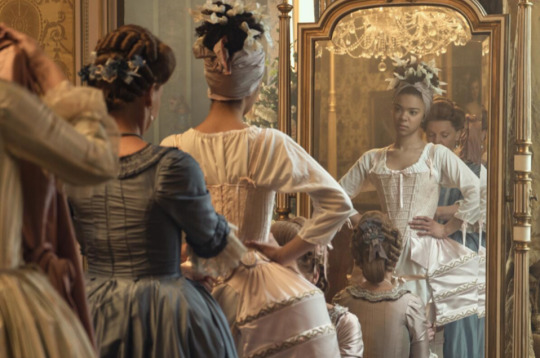
Fabrics and Patterns
The main fabrics used in the construction of these fascinating costumes consisted of taffeta, silk, velvet, lace and mesh fitting with the fashions of the time and truly showing the Georgian style. The patterns however were not as Georgian as other aspects of the costumes, although they still replicated and linked with it, there was a much more modern twist, as the patterns were more muted and simplistic in comparison to the traditional patterns which include a variety of colours rather than the monochromatic theme we see in a large number go garments. In contrast, floral patterns are still the main focus like in the Georgian period, being featured in a number of elaborate gowns.
Shape / Silhouette
The iconic Georgian Silhouette features the large hips and cinched waist and although the hips are not as dramatic and huge as many gowns of the period were as shown below...

... but they still have that essence and style however with a more functional and modernised element. In addition, tight sleeves, square necks and high backs are seen in practically every garment creating this identifiable shape and style lines helping to create this base for my design. Furthermore, another common aspect is the asymmetrical sleeves where they are longer and the back and shorter at the front forming a tiered bell sleeve type of shape.
Cloaks
Throughout the series when a female character is seen to go outside in the cold or at night their gowns are paired with an equaly stunning cloak. The cloaks feature a large hood and a fairly simple design with a solid colour as the base however all with their own unique twist. We see some with frills and detailing around the edges and others with intricate ties at the front such as bows and brooch like designs as shown by some cloaks featured in the series below.

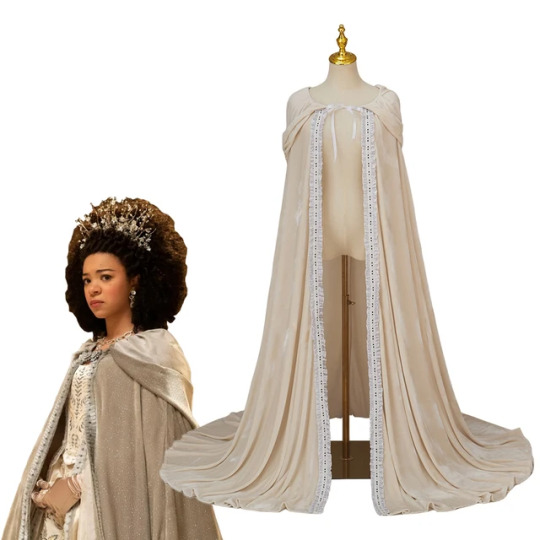

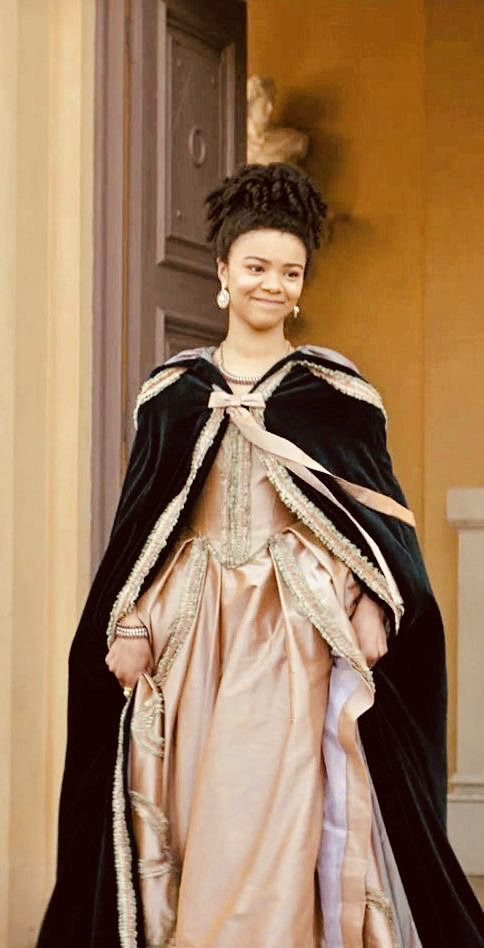
Sack-back Gowns
A sack-back gown was originally seen as an informal garment at the beginning of the 18th century, it was unfitted and loose, falling from the shoulders in a bell-like shape. From here, the gown developed being defined by the row of two double box pleats sewn in at the center of the neckline at the back of the dress which fell loose from the shoulder to the floor with a slight train. Although this is the main feature of the gown, they often feature open fronts, showing off a decorated stomacher and petticoat.
We see sack-back gowns are a popular style for the show, featuring in a number of iconic outfits however mainly seen to be worn by the older Queen Charlotte and young Lady Danbury rather than young Queen Charlotte, however I still love the effect it creates forming such an elegant and structured silhouette whilst also forming such a detailed and sophisticated design really drawing the viewer in.
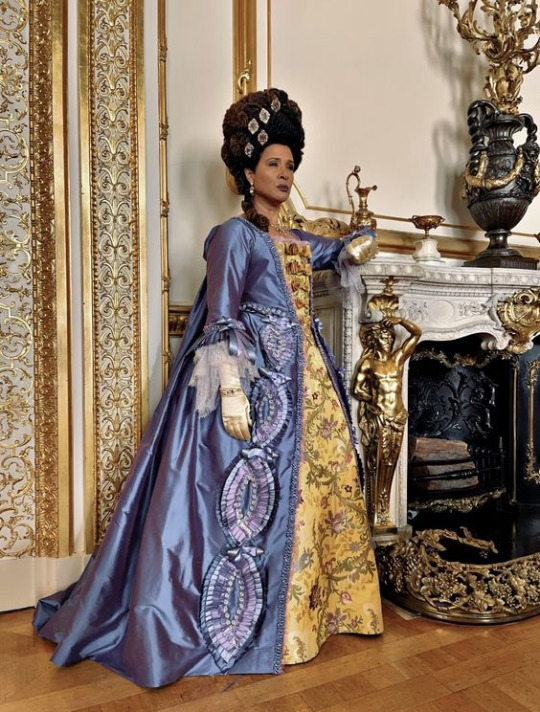



0 notes
Photo

Stays, 1760, France.
59 notes
·
View notes
Text

Painting, ca. 1760, French.
By Guillaume Voiriot.
Portraying a woman at her toilette.
Musée des Arts Décoratifs Paris.
#painting#1760#1760s#1760s France#1760s painting#toilette#guillaume voiriot#mad Paris#musée des arts décoratifs paris#France#French#hair#1760s hair#undergarments
26 notes
·
View notes
Photo


Stays with Hip Pads
1750-1775
Europe
The MET
#stays#fashion history#historical fashion#1750s#1760s#1770s#rococo era#18th century#europe#pink#floral#hip pads#silk#cotton#whalebone#undergarments#the met#popular
784 notes
·
View notes
Text
I had a VERY productive weekend: I cut my Edwardian undergarments, and I sewed the chemise and the French drawers, and started the corset cover. I also cut the corset pattern, but not the fabric. I had ALL the materials for this project ready since a long time ago, so everything was quite smooth.
Now, I was so productive that I didn't take any photos of he garments XD and since I don't have a sewing machine at my apartment, I can only sew at my parent's home. So, I guess tomorrow I'll go and try to finish the corset cover :) Thank god we live so close to each other! BUT here a photo of my senior dog just sitting on my leg because he felt like it:

Yes, I LOVE those JW Anderson x Converse shoes. I regret nothing.
Also, all the curves on that 1903 corset make me scared D: Here, I took a photo of the cut pattern:

This pattern also includes hip and bust pads, so I shall have the full-and-definitely-not-natural Edwardian silhouette.
If anyone is interested, there are the patterns I'm using, all from Truly Victorian:
TVE01 - 1903 Edwardian Corset
TVE02 - Edwardian Underwear
45 notes
·
View notes
Text
ok this took way longer than i expected because i got sidetracked looking at paintings and reading poetry and just admiring the mv, but it's finally finished!! let's talk about
higher
✨
i'm going to draw your attention to a few things.
firstly, these verses from rime of the ancient mariner by samuel taylor coleridge, published 1834:
The harbour-bay was clear as glass,
So smoothly it was strewn!
And on the bay the moonlight lay,
And the shadow of the Moon.
The rock shone bright, the kirk no less,
That stands above the rock:
The moonlight steeped in silentness
The steady weathercock.
And the bay was white with silent light,
Till rising from the same,
Full many shapes, that shadows were,
In crimson colours came.
A little distance from the prow
Those crimson shadows were:
I turned my eyes upon the deck—
Oh, Christ! what saw I there!
Each corse lay flat, lifeless and flat,
And, by the holy rood!
A man all light, a seraph-man,
On every corse there stood.
This seraph-band, each waved his hand:
It was a heavenly sight!
They stood as signals to the land,
Each one a lovely light;
This seraph-band, each waved his hand,
No voice did they impart—
No voice; but oh! the silence sank
Like music on my heart.
secondly, this ivan aivazovsky painting, chaos (the creation), c. 1841:
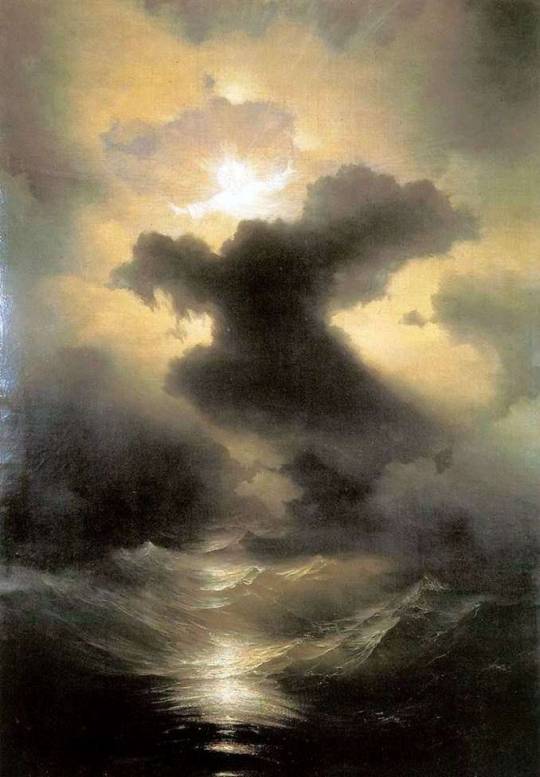
and thirdly, the memorial of percy shelley, who drowned in a boating accident at age 29, in 1822:
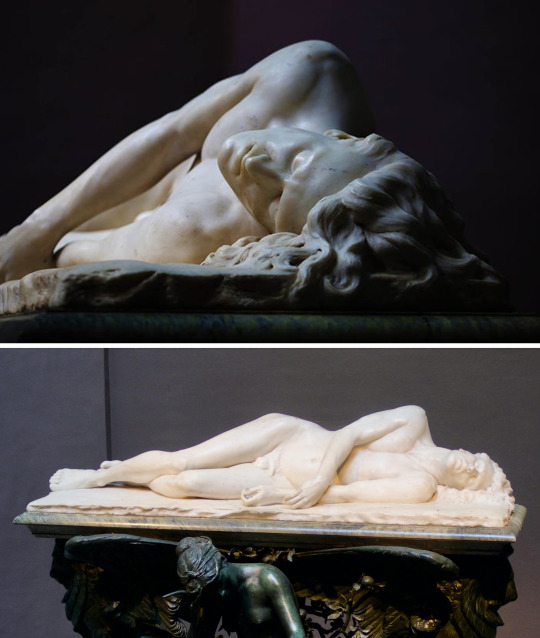
there's a common conflation between the romantic and the pastoral in the general cultural consensus because the pastoral a) has been around as an art term longer than romantic, and b) romanticism does use some similar imagery. but there is a key difference: the pastoral is specfically an idealization of 'the simple shepherding life,' often for high class and urban audiences who have no conception of the details of this life includes. one of the more famous examples is christopher marlowe's a passionate shepherd to his love, published in 1599:
Come live with me and be my love,
And we will all the pleasures prove,
That Valleys, groves, hills, and fields,
Woods, or steepy mountain yields.
And we will sit upon the Rocks,
Seeing the Shepherds feed their flocks,
By shallow Rivers to whose falls
Melodious birds sing Madrigals.
And I will make thee beds of Roses
And a thousand fragrant posies,
A cap of flowers, and a kirtle
Embroidered all with leaves of Myrtle;
A gown made of the finest wool
Which from our pretty Lambs we pull;
Fair lined slippers for the cold,
With buckles of the purest gold;
A belt of straw and Ivy buds,
With Coral clasps and Amber studs:
And if these pleasures may thee move,
Come live with me, and be my love.
The Shepherds’ Swains shall dance and sing
For thy delight each May-morning:
If these delights thy mind may move,
Then live with me, and be my love.
whereas romanticism is a more pointedly specific movement that was active from around 1800 to 1850, primarily focused on intense emotion and catharsis as the primary experiential output of an artwork. which most prominently manifested in a deep fascination and glorification of the natural environment and historical nostalgia. the movement sprung from the german sturm und drang (literally storm and drive/stress) period of the late 1760s to early 1780s, which was a direct reaction to rationalism and enlightenment. romanticism had similar impulses; it was also a revival of medievalism and a reaction against the looming urban sprawl and mechanization of the industrial revolution. a typical romantic poem from one of the originators of the english movment william wordsworth, composed upon westminster bridge, september 3, 1802, originally published 1807:
Earth has not any thing to show more fair:
Dull would he be of soul who could pass by
A sight so touching in its majesty:
This City now doth, like a garment, wear
The beauty of the morning; silent, bare,
Ships, towers, domes, theatres, and temples lie
Open unto the fields, and to the sky;
All bright and glittering in the smokeless air.
Never did sun more beautifully steep
In his first splendour, valley, rock, or hill;
Ne'er saw I, never felt, a calm so deep!
The river glideth at his own sweet will:
Dear God! the very houses seem asleep;
And all that mighty heart is lying still!
this romantic fascination with nature was underpinned by the philosophy of the sublime, generally agreed to be first treatised by edmund burke in 1756, the theory was also written about by kant and hegel. in the simplest of terms, the sublime is a quality of greatness beyond calculation, imitation, and human comprehension. the sublime is twofold; the greatness of the ocean is beautiful, but its power is also terrifying, and the experience of the sublime is to feel those two at once. to be in awe and also to be horrified of its ability to sink ships and drown a life in a tempermental change of tide.
let's take a quick detour to talk about
clothing
in the present day we have become much more lax thanks to the aesthetic movement in the late nineteenth century, but back in the early victorian period there are still highly structured rules about when and what clothing one can wear in public. and the clothing itself is also highly structured. anyone with a passing understanding of the victorian era knows about the whole flashing of the ankle thing and corsets galore, and it is true that the general day to day garments cover a lot of area. for men in particular, this manifests in no less than three layers in public at all times: shirt, waistcoat, and suit jacket, with a coat or mantle overtop in colder temperatures. this also includes a variation of a neck tie (depending on what year), hat, gloves, and any other decided upon accessories (this can also include a corset and other padded structural underpinnings).
an important tangent to mention here is that this is the uniform of the upper classes, although the rules do apply to the lower classes if they wanted to appear 'sophisticated.' the working man's uniform was also shirt, waistcoat, trousers, but the difference here is in the textiles themselves; the colours tended to be much more drab, with less complicated patterns. obviously due to the price fabric itself, but also due to the labour of laundry. an indicator of class here is the white shirt itself and its pristine implications. (there is a longer conversation here about the invention of neckties and detachable collars and cuffs, but that's for another day).
the silhouettes are very important to note here in the higher mv, as they are directly referential to the 'romantic poet' archetype of loose shirt and tight pants that we see in popular culture. but as i've just said, the reality is that men of the era were not dressed like this out in public. this look is essentially underwear; the implications are salacious. so where did this come from? well, we can blame it mostly on lord byron, who by all accounts was the first western 'rockstar.' notoriously called 'mad, bad and dangerous to know' by lady caroline lamb (a married women he publically had an affair with), byron was openly bisexual and deeply hedonistic with a lot of questionable habits, but his poetry was so popular that he was known to have women following him in the street and gathering in large quanities to see him at salons. and this was close to three decades before lizstomania. his close friends and contemporaries included percy and mary shelley, with whom he lived with abroad in italy for some time (this living arrangement resulted in the writing of both frankenstein and john polidori's the vampyre). byron's reputation was so eclipsing that the image of the lush poet lazing in his undergarments has become its own genre of romantic, slightly removed from the movement byron was writing in. it's also worth it to point out that there are no official portraits of byron dressed like this from the time. the visual assumption is somewhat apochryphal.
now let's get into some specifics. a.c.e is not unfamiliar to this silhouette; as previously mentioned in this post i wrote about their styling, the boxy loose upper and fitted lower is their general mode for their styling because of its emphasis on legs. cactus was the most extreme example of this, and to prove my point, this specific silhouette is extremely common in classical ballet:
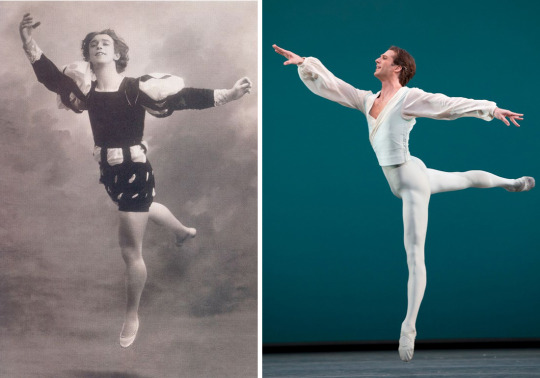
1. vaslav nijinsky, giselle, 1911
2. nehemiah kish, george balanchine's ballo della regina, 2011/12
higher fits very neatly into this same category: we have an emphasis on the legs through tightly fitted garments and also through light reflective textile, as well as a secondary emphasis on arm and shoulder movements with looser fit shirts. plus, the shirts are made from fabrics that have good drape and flow, and mimic the visual effects of water:

there are also several instances of scale patterning and wetlook hair styles, further elabourating on the siren theme. and the jewelry is the same, purposefully cut clear stones for oceanic sparkle or pearls, the gem directly born from water, as highlighting accents to specific parts of the body - namely eyes, hands, and torso:

the body jewelry also serves a double purpose in addition to being sparkly; it gives a semblance of shape to their torsos so their movements aren't totally lost in the shroud of their shirts, and it also invokes some of that salacious element that us as a modern audience doesn't necessarily perceive in the same way when we see a man wearing only a shirt. all of these points are especially prominent in the stage costuming. concerning the veils, these are an aesthetic choice following the theme of depicting water without actually using water. the song has a very breathless quality to it, and the lyrics directly make reference to water and breathlessness, so it only makes sense to have a physical manifestation of struggling to breathe.
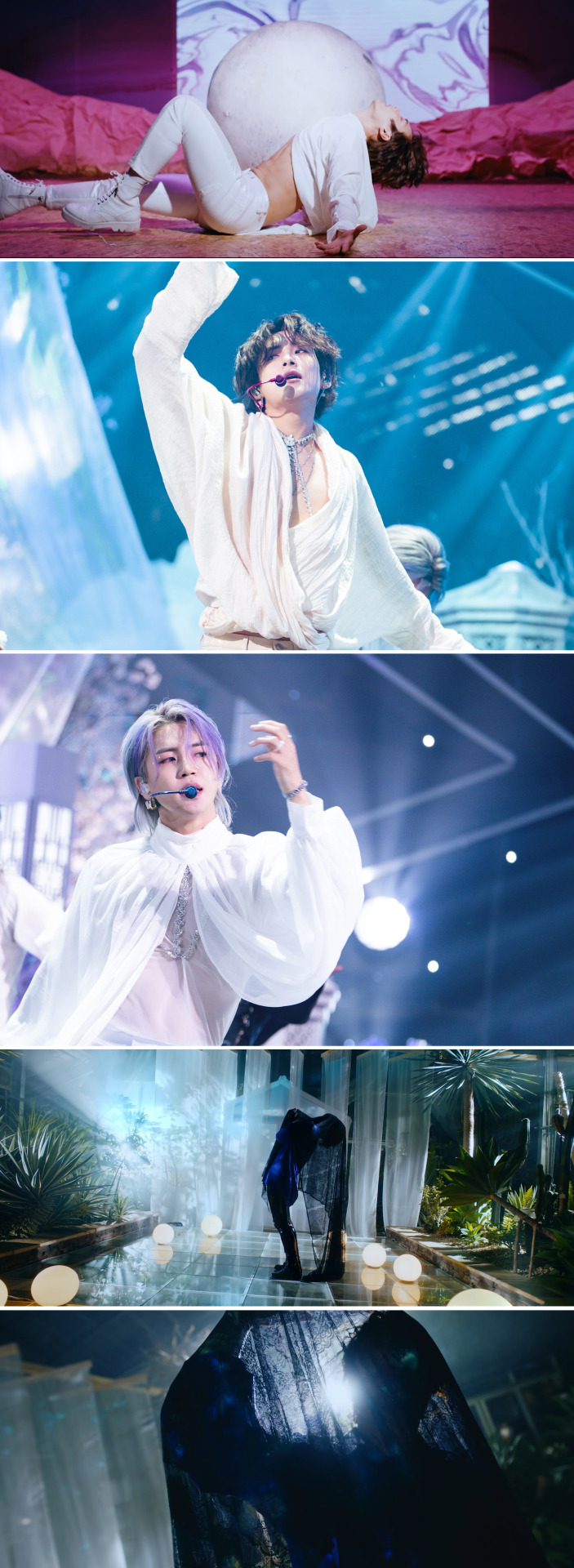
now let's talk about
mise-en-scène
unlike most kpop mvs, I would argue that higher is not a spectacle in what we normally see spectacle to be. the overwhelming visual saturation of goblin (and the goblin remix) is more in line with what we expect, but how do you follow that, top it? the answer is that you don't. you aim for something with a completely different feel, which is exact what they did with higher.
the performing arts did not escape romanticism. the very start of the movement, sturm und drang, is actually named from a specific play written by friedrich maximilian klinger that premiered in 1777. the plays of the brief period are characterized by extreme and passionate emotions, and were siblings to one of the most famous genres of theatre, the melodrama. meant to appeal directly to the emotions of the audience using sensationalist plots and stock characters, the melodrama was the predominent form of entertainment in victorian england and gradually developed a specific form of its own. in this period we also start to see the development of 'stagecraft' into the recognizable form that it takes today. footlights, limelight/spotlighting, the separation of house and stage lighting, fly galleries, elevator platform mechanics, and the first (purported) western use of rear projection are all innovations of the late 18th and 19th centuries, as melodramas were known to have very intricate and spectacular stagings. and to go along with these stagecraft mechanics we see the rise in designated stage crews, which were predominantly off-duty sailors looking to make money. the rope systems that made up the fly galleries were very similar to that on ships, and much of the terminology and supersitions crossed over: this is the origin of the term 'rigging' being used for suspending set elements, and also the origin of the 'don't whistle in a theatre' superstition. as sailors communicated with whistle patterns on ships, the same system was adopted for changing scenery, and therefore whistling a random pattern could potentially drop a setpiece on an unsuspecting victim.
so with all this backstory out of the way, what is the very first full location we see? a stage, complete with forced perspective via the painted fabric legs (the side panels) and borders (the wavy upper panels). we even have a flat painted backdrop with a projection screen and hanging overhead lamps. there's also a second interior set, a desk in what looks to be a study of some kind. bit self explanatory on this one, taking the poet notion on the nose.

the locations have a bit of an obtuse arc, but it's there when you look for it. it starts interior spaces, where the ideas of sublime attempted to be recreated for the viewer. then it moves to transitory spaces; portions of nature isolated from a whole environment, interjections of human architecture into natural spaces:
(the white hut structure in the greenhouse is reminiscent of a skene (literally hut/tent), which is the structure at the back of the stage in ancient greek theatre used for the actors to change their masks and costumes. it was originally temporary, but slowly transformed into permanent stage architecture)

and then finally outdoors, into the sublime itself:

jwm turner, crossing the bridge, 1815
lastly,
lighting
there's a very clear lighting pattern here, primarily in light and dark. the base colour story is fairly simple complementary pairs; there's a lot of purple/red and green, and blue and yellow/amber, with everything relatively on the same tonal level. there are deliberate interjections of heavily saturated red for specific effect. there are also, most notably, a 'dark' version of all the sets. obviously as a reference to the eclipse that we see in the mv and in the concept photo series, but also as a reference to that darker undercurrent of the sublime, the upsetting, the uncanny, and the terrifying:

And the bay was white with silent light/Till rising from the same/Full many shapes, that shadows were/In crimson colours came.
#a.c.e#ace w#kpop analysis#group analysis#me - a staunch defender of kpop as valid spectacle: actually this one is a melodrama its meant to hit different#this essay is otherwise known as the quickest and dirtiest history of romanticism ever#i really should have pointed out that when i say romantic i mean romantic with a capital r#that probably would clear up some confusion but i have an aesthetic to maintain do not @ me#this is potentially the most pretentious thing i have ever written i am so sorry if this makes no sense#some of these connections are so tenuous who let me have opinions on the internet#did i write this as an excuse to look at the percy shelley memorial because i am obsessed with it as a piece of art? maybe#anyways read tom stoppard's arcadia if you want to know more about that#you should read all this with the caveat that the sublime and romanticism need to be deconstructed through a postcolonialist lens#because these theories are super colonialist about 'unclaimed untameable natural spaces'#when in reality most natural spaces are specifically architected by indigenous peoples in order to preserve and coexist with the ecosystem#this is may be more obviously applicable to american subliminal painting than european but it still applies#since the british were notoriously good at fucking up every kind of expedition ever#because of their lack of respect for literally anything and everything#and their inability to listen to anyone other than another white british person#see: history of the northwest passage#im a bad theorist and not caught up so i didnt get that deep into it because counter to the wordcount#i am not trying to write another dissertation#this is not as well researched as it could be but also im not reading burke and kant again#also yes byron the shelleys and polidori did just bang out the foundations for all of science fiction and romantic vampire mythology#in like three days because the all got bored during a storm and want to try and 'outscare' each other#also by 1840 like every prominent romantic poet was dead either from their own stupidity or tuberculosis#with the exception of wordsworth that motherfucker started the movement and then outlived it#text
17 notes
·
View notes
Text
Anonymous asked: You sound like a remarkable woman out of her time. Your posts suggest you are modern and feminine yet your cultured intelligence and cleverness seems from an earlier lost time. Would you prefer to be living in 18th Century Georgian England? One imagines you would fit right in as a heroine in Jane Austen’s Regency world of aristocratic manners and clever barbs over tea in the drawing room.
I had to smile to myself a little because the last thing I ever saw myself was a Jane Austen character. I certainly don’t see myself as heroine of Austen’s world. After all don’t most if not all of Austen’s literary heroines spend their time pathetically pining away for the socially aloof and yet heroically vulnerable gentlemen they profess to love, men who are usually too dense to know that these whining women have childish schoolgirl crushes on them? I know I’m going to angry mails now from pouting Austen fans but I have to speak my mind.
Like most people I do profess to liking a nice, cosy Jane Austen adaptation on television. The fabulous frocks, fans, feathers and finery soothe us with images of a gentler, well-mannered time when gentlemen in cravats and breeches wooed perfumed ladies across ballrooms and well-manicured lawns.
However the reality was not quite so lovely. It’s not that women - like Austen’s literary women - were caught up in the social constraints of their time but also I would get restless just sitting down all day to tea and gossip. I would sooner catch the first ship bound for India and have adventures in the Orient along the way. Tea with Mr Darcy in well stuffed breeches might not be enough for me but then again a well stocked library as most landed gentry homes had would make me reconsider.
I’m fortunate that within my family we have a wealth of diaries, correspondence, private papers, and other family heirlooms that go back a few centuries which we have scrupulously stored to hopefully pass onto future generations.
So when I can decipher some letters of my ancestors it gives me some insight into what life was like for them as men and women of their time. It’s not always easy to read as they loved to scribble in ink (now faded) in the margins on nearly every page of the books they read. And so the penmanship is stylish but minuscule and therefore sometimes hard to make out. The letters are somewhat more legible but it requires patience and perseverance to make sense of what they were writing about. It’s a wonderful way to flesh out the genealogical tree with titbits of personal anecdotes that could be perfunctory, mundane, scandalous, salacious, romantic, and even political.
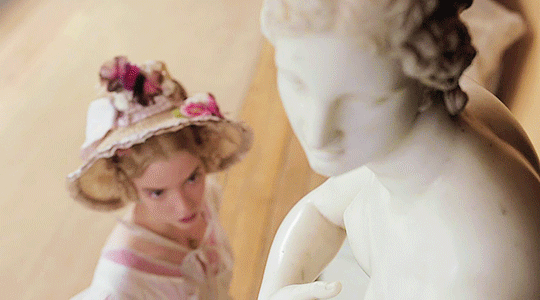
I’ve read Jane Austen like every other girl at boarding school I imagine. I like her writings but I wouldn’t say my heart is in it to actually live through that time.
Life for Georgian women, even of high birth, was harsh enough in a time when men still held all the power and husbands could beat and even rape their wives. Noblewomen caught diseases passed on from their husband's prostitutes and were still subjected to confinement and the barbaric medical practice of bleeding when pregnant. Even their fashions and frippery provided cold comfort when their make-up poisoned them, unwashed dresses and undergarments stank and their fancy foods made their teeth rot and fall out.
The fact that women did survive and even thrive is a testament to their strength and fortitude which I find admirable.
I’m used to mud and sweat and even living rough because as ex-army officer I was trained to suck it up but it’s also in my nature because I love going rough when I hike or climb mountains or trek to other places off the beaten track. So I’m not squeamish so long as at the end of the day I can bathe or shower my aches away and I can put on a fresh change of clothing. However even I recoil in some horror when I consider that despite their elegant appearance, Georgian women carried a world of stench. While hands and faces would be washed daily, immersive bathing was considered bad for the health and was only indulged in occasionally.
The heavy gowns of the period would have caused the wearer to sweat profusely, with only perfumes such as rose water and orange blossom to mask the smell. The clothes themselves would also be pungent. Due to the huge amount of work involved in laundering, most households would have a maximum of one wash-day a month. Linen undergarments were changed as often as possible, but their "clean" smell would still be unappealing to us. Linen was often bleached in chamber lye, a kind of soap made from ashes and urine.

As if bodily odour was not bad enough, there was also the whiff of rotting teeth. A sugar-rich diet led to frequent tooth-decay in the upper classes. Cleansing tooth-powders had started to emerge but most of these featured "spirit of vitriol", known to us as sulphuric acid, and stripped teeth of their enamel. Often the best remedy for smelling teeth and bad breath was to chew herbs such as parsley. Where a tooth was past hope of redemption, it would be pulled with pliers or a tooth key, a claw that would fix to the teeth so it could be loosened in the jaw. To avoid a gummy smile, ladies of fashion sought false teeth made from ivory or porcelain but, where possible, they preferred to have "live" teeth in their dentures. Poor people were encouraged to sell healthy teeth for this purpose. While such a practice was unethical, it was better than the other method of sourcing human teeth: pillaging them battlefields and graveyards.
Georgian women were renowned for their snowy faces and dark eyebrows but achieving the fashionable skin tone could be extremely dangerous. White face powders were lead-based and some also featured vinegar and horse manure. Years of coating the entire face, shoulders and neck with such a mixture could lead to catastrophic consequences. Society beauty Maria Gunning died at the age of just 27, having spent her life addicted to cosmetics. Lead-poisoning could cause hair loss and tooth decay but ingeniously, these problems were elegantly adapted into the fashion and it became desirable to have a high forehead and pencil-thin eyebrows. If your own eyebrows failed you completely, you could always trap a mouse in the kitchen and use its fur to make a new artificial pair.

I usually wear my hair straight or tied up in a bun so I don’t fuss too much over my hair. This would certainly be out of place if I lived in Georgian times. Georgian ladies were the mistresses of big hair. They piled their frizzed and curled locks over pads or wires to create show pieces for the drawing room. Often their own hair was not sufficient and had to be supplemented by horse hair and false pieces. Styles from the 1760s were domed or egg-shaped, elongating into the pouf in the 1780s. But Georgiana, the infamous Duchess of Devonshire, had to take things a step further. She introduced the three-foot hair tower, ornamented with stuffed birds, waxed fruit and model ships. Following her example, women competed with one another to make the tallest headdress.
Since these styles were costly and took hours to arrange, they were worn for several weeks. Ladies had to sleep sitting up and travel on the carriage floor to avoid spoiling their creations. With no combing possible, lice were inevitable so a special scratching rod was invented for irritated ladies to poke into their piled up hair.
It wasn’t any real fun being a woman and I often think Jane Austen is selling a false bill of goods in her books. You never see women in her novels deal with their menstrual problems. No one has proved for certain what they did, if anything, for sanitary hygiene. With no knickers to hold in strips of linen or rag, they were left to Mother Nature’s mercy. I can imagine that being a conversation stopper in the drawing room over tea with the vicar and his prissy wife.
Their toilet habits were a little more civilised. When ladies at the royal court were caught short, they resorted to porcelain jugs much like a modern-day gravy boat. This contraption, called a bourdaloue, was stuffed up beneath the skirts and clenched beneath the thighs. Apparently it was quite normal for a lady to continue her conversation while urinating into the device! I think Jane Austen missed a trick by not having at least one scene with Elizabeth Bennet urinating under her skirts whilst trading clever barbs with Mr Darcy.
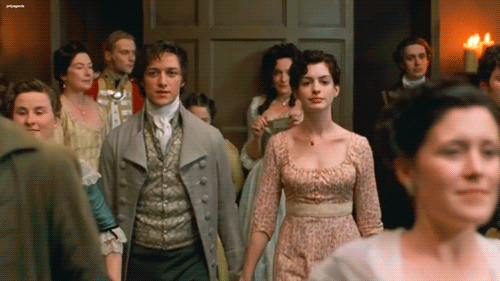
Speaking of which marriage was not a box of chocolates in the early 18th Century or indeed later in Austen’s day. Upon marriage, a lady and all her worldly goods would become property of her husband. It was therefore essential to guard a well-to-do bride’s interests with a legal marriage settlement before the ceremony took place. I read somewhere that Henrietta Hobart, later mistress to George II, had reason to be thankful for the settlement drawn up before her marriage to Charles Howard in 1706. It stipulated that two thirds of her dowry should be invested, with the interest at her sole disposal. Should Henrietta die, the funds were to pass to her children. This arrangement was to prove life-saving when her husband became an abusive gambling-addict and alcoholic.
Lower class women were known to take extreme measures to protect their future husbands from their own debts. "Smock weddings" were intended to show that the bride brought no clothes or property to the union, thus exempting each spouse from the other’s financial liabilities. The woman would be married wearing only her undergarment or smock – or sometimes nothing at all.
Of course no marriage settlement, however generous, could save a woman from a violent husband and it remained legal for a man to rape or kidnap his wife. While excessive beating was frowned upon, whipping was considered a reasonable measure to discipline a wife. Even so, it would appear many men pushed their rights beyond the limit, for laws were later amended to say a man could only beat his wife with a stick "no thicker than his thumb".
Escaping an abusive marriage then was well-nigh impossible. Divorces were so expensive that they remained the privilege of the very rich. Even if a lady did have the money to appeal for divorce, she was by no means certain of success. She would have to prove both adultery and "life-threatening cruelty". And if she won her freedom, it would come with more than just a social cost - any children from the marriage would remain property of the husband. Certainly in my family - on my father’s English side of the family - they had their fair share of scandalous behaviour that didn’t reflect well to our 21st Century minds.

Certainly the Georgians were not sexless and they enjoyed their carnal pleasures but of course being aristocratic they never did things that would publicly expose them to scandal. I was reading one such letter of an ancestor who was writing to her older sister about how hard it was for her to conceive her first child - a son naturally - that her rakish husband first took to prostitutes in an era when such things were common and the risk of infection from sexually transmitted diseases was rife. And then later settled on one mistress whom he seriously gave thought to impregnate her. However the mistress was an actress and thus such a union was frowned upon in landed gentry circles and so he was shamed back to his high born wife and to ‘try harder by God’s Providence’. The duty of any aristocratic wife was to produce a healthy son and heir but if nature did not take its course, they could seek help and so these ancestors of mine did.
Like many other aristocratic couples with trouble conceiving children they sought out quacks who made promises to cure infertility. One such person was a Dr James Graham who had invented what he called ‘The Celestial Bed’ that guaranteed conception and unearthly sexual pleasure. The bed itself was electrified and stood on insulating glass legs. The mattress was stuffed with stallion hair to increase potency. Mirrored floors and music from a glass harmonica heightened the experience, while the air swirled with exotic perfumes. Having made love on this bizarre contraption, the couple were encouraged to take ice baths and have a firm massage. The lady would also be advised to douse her genitals with champagne.

It must have worked because the family line did not die out but flourished. It proves to me that champagne is the answer to almost every question in life.
A woman’s travails were not over just because she was successfully pregnant. More hazards lay in her path. Despite advances in medicine, a shocking number of medieval practices remained in the Georgian birthing chamber.
The long period of rest or "confinement" leading up to the birth was still enforced for wealthy women. The rooms would be kept dark and sweltering with the expectant mother wrapped up in fustian waistcoats and petticoats. As soon as she had given birth, the room was made even hotter, with the curtains round the bed pinned and even the keyhole in the door stopped to prevent a draft. When I lived in China I discovered this is what Chinese mothers did and still do to this day. So I wasn’t so surprised when I read such a practice happened in other cultures like my own.
Those more fortunate might find themselves in a birthing chair. This had a sloped back and a semi-circle cut from the seat, designed to let gravity aid nature. It was certainly a better option than staining expensive bedding and linen. With only female relatives and an unofficially trained midwife to help, many women and their babies died in childbed, as it was known. Even when male surgeons became involved in obstetrics toward the end of the century, treatments were woefully inadequate. I read in the correspondence of one of my female ancestors that she was frequently ‘bled’ during her pregnancy. Somehow she survived any risk of post-partum haemorrhage.
Even when a birth was successful without complication the wife/mother was not out of the woods just yet. In keeping with custom in landed gentry circles of the times, the new mother would not suckle their own babies. In keeping its custom this taks was given over to a wet nurse. In the case of one of my ancestors whose correspondence I read she got a village girl from the family estates to breast feed the baby. The reason for doing so was brutally simple. Firstly, it was to ensure that the lady could conceive again as soon as possible. And secondly, Wealthier women often had difficulty breastfeeding due to their tight corsets or stays. It was also believed that a child would grow up stronger and hardier with a country-woman’s milk.
But even when the baby sprog was weaned, it was common practice for it to be handed to foster-parents until it was old enough to run about and talk. Interestingly enough Jane Austen and her siblings were fostered by a cottager in Deane village, two miles from their family home.

So overall I’m no so sure I would be thrilled to be living in the Georgian and Regency era even if it meant challenging that scoundrel Mr Wickham to a sword duel (and kicking his arse), match making with Emma, or even missing out on the pleasure of taking tea with Mr Darcy.
Sorry Mr Darcy.
Of course I’m fascinated with history and one sometimes wonder what it might be like to live in a particular time. However it’s just a flight of the imagination because to paraphrase Sir Roger Scruton I prefer to live in “the pastness of the present” rather than the past itself. This is the difference between being an historically illiterate reactionary and being a true conservative.
Thanks for your question
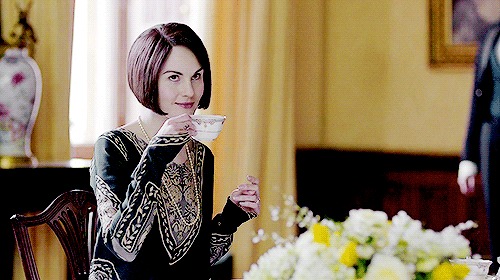
37 notes
·
View notes
Photo
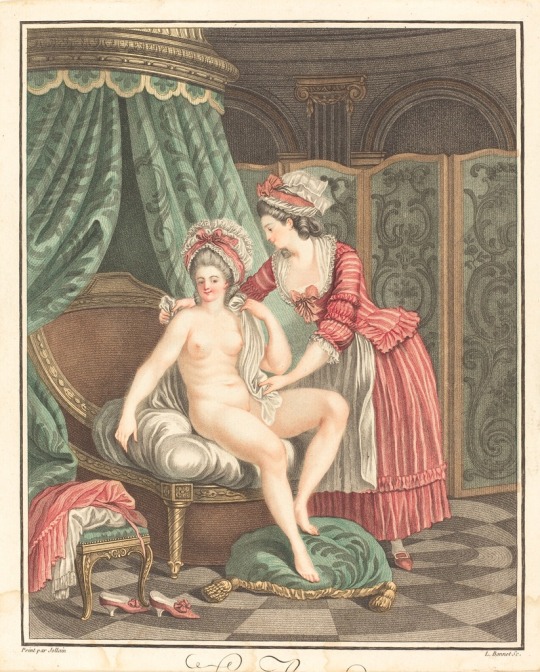
This will be my first full exploration into 18th century dress! I will be building the dress of the maid on the right from the undergarment up to her bow. This piece is by Louis-Marin Bonnet, he was a French artist who was around from 1736 - 1793. Based upon the robes shortness and the length of the dress I’m placing this dress circa 1760′s. Keep an eye out for my designs and design explanation!
#fashionhistory#history#historian#fashionhistorian#rococo art#fashion history#18th century#french history#french fashion#18th century france#Orignial practice#Beginner historian#Fashion
7 notes
·
View notes